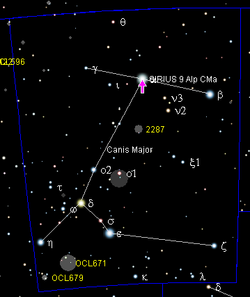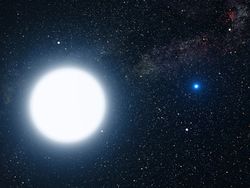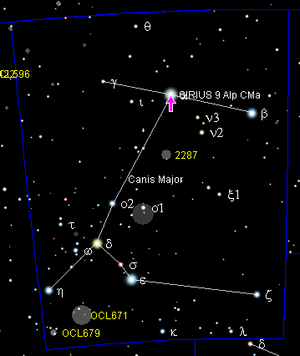الشعرى اليمانية
| بيانات الرصـد الحقبة J2000.0 (ICRS) اعتدال J2000.0 (ICRS) | |
|---|---|
| الكوكبة | الكلب الأكبر |
| الصعود المستقيم | 06س 45د 08.9173ث[1][2] |
| الميل | −16° 42′ 58.017″[1][2] |
| القدر الظاهري (V) | −1.47 (A)[1] / 8.30 (B)[3] |
| الخـصـائص | |
| النوع الطيفي | A1V (A)[1] / DA2 (B)[3] |
| U-B دليل الألوان | −0.05 (A)[4] / −1.04 (B)[3] |
| B-V دليل الألوان | 0.01 (A)[1] / −0.03 (B)[3] |
| علم القياسات الفلكية | |
| السرعة القطرية (Rv) | −7.6[1] كم/ث |
| الحركة الحقيقية (μ) | RA: −546.05[1][2] mas/yr Dec.: −1223.14[1][2] mas/س |
| اختلاف المنظر (π) | 379.21 ± 1.58[1] mas |
| المسافة | س ض ( ف ن) |
| القدر المطلق (MV) | 1.42 (A)[5] / 11.18 (B)[3] |
| المدار[6] | |
| Companion | α CMa B |
| Period (P) | 50.09 yr |
| Semimajor axis (a) | 7.56" |
| Eccentricity (e) | 0.592 |
| Inclination (i) | 136.5° |
| Longitude of the node (Ω) | 44.6° |
| Periastron epoch (T) | 1894.13 |
| Argument of periastron (ω) (secondary) | 147.3° |
| التـفـاصـيل | |
| الكتلة | 2.02[7] (A) / 0.978[7] (B) M☉ |
| نصف القطر | 1.711[7] (A) / 0.0084 ± 3%[8] (B) R☉ |
| الضياء | 25.4[7] (A) / 0.026[9] (B) L☉ |
| جاذبية السطح (ج) | 4.33[10] (A)/8.57[8] (B) س.ج.ث. |
| درجة الحرارة | 9,940[10] (A) / 25,200[7] (B) ك |
| المعدنية | [Fe/H] =0.50[11] (A) |
| الدوران | 16 km/s[12] (A) |
| العمر | 2-3 × 108[7] سنة |
| تسميات أخرى | |
الشِّعْرَى اليَمَانِيَّة أسطع النجوم في السماء ليلاً (أي أكثرها لمعانًا وبريقًا)، وهي نَيِّر كوكبة الكلب الأكبر. يبلغ بريقها 25 ضعف بريق الشمس. يصنف الفلكيون الشعرى اليمانية نجمًا ثنائيًا، لأنها في الحقيقة عبارة عن نجمين مترافقين، هما:
تبعد الشعرى اليمانية 2.6 فرسخ نجمي (8.6 سنة ضوئية) عن الأرض، وهي بذلك تكون إحدى أقرب النجوم من الأرض.
تاريخ الرصد
هيروغليفية |
اكتشاف رفيق
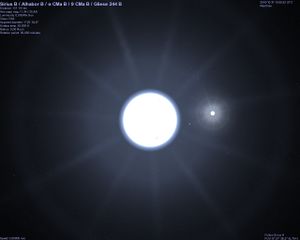
إمكانية الرؤية
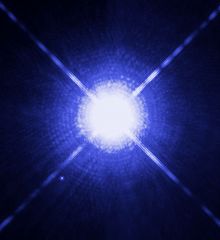
الشعرى اليمانية
ذكر في القرآن في سورة النجم : { وأنه هو رب الشعرى }
عنقود الشعرى اليمانية الهائل
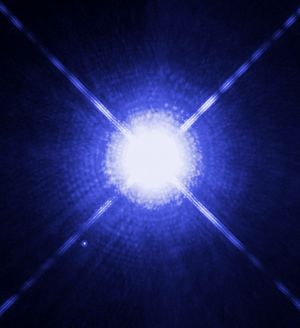
في 1909, إينار هرتسشپرونگ كان أول من اقترح أن الشعرى اليمانية هي عضو في مجموعة الدب الأعظم المتحركة، بناء على أرصاده لحركات النظام عبر السماء. ومجموعة الدب الأعظم هي مجموعة من 220 نجم لها حركة مشتركة عبر الفضاء وكانت في وقت ما تُعتبر أعضاء عنقود مفتوح، إلا أنه انفرط جاذبياً منذ ذلك الحين.[16] However, analyses in 2003 and 2005 found Sirius's membership in the group to be questionable; the Ursa Major Group has an estimated age of 500±100 million years, while Sirius, with metallicity similar to the Sun's, has an age that is only half this, making it too young to belong to the group.[7][17][18] Sirius may instead be a member of the proposed Sirius Supercluster, along with other scattered stars such as Beta Aurigae, Alpha Coronae Borealis, Beta Crateris, Beta Eridani and Beta Serpentis.[19] وهو أحد ثلاثة عناقيد كبيرة تقع ضمن 500 سنة ضوئية من الشمس. المجموعتان الأخريان هما Hyades و Pleiades، وكل من هذين العنقودين يتكون من مئات النجوم.[20]
طالع أيضاً
المصادر
- ^ أ ب ت ث ج ح خ د ذ ر Database entry for Sirius A, SIMBAD. Accessed online October 20, 2007.
- ^ أ ب ت ث Astrometric data, mirrored by SIMBAD from the Hipparcos catalogue, pertains to the center of mass of the Sirius system. See §2.3.4, Volume 1, The Hipparcos and Tycho Catalogues, European Space Agency, 1997, and the entry for Sirius in the Hipparcos catalogue (CDS ID I/239.)
- ^ أ ب ت ث ج Entry for WD 0642-166, A Catalogue of Spectroscopically Identified White Dwarfs (August 2006 version), G. P. McCook and E. M. Sion (CDS ID III/235A.)
- ^ Entry for HR 2491, Bright Star Catalogue, 5th Revised Ed. (Preliminary Version), D. Hoffleit and W. H. Warren, Jr., 1991. (CDS ID V/50.)
- ^ For apparent magnitude m and parallax π, the absolute magnitude Mv of Sirius A is given by:
- ^ Gatewood, G. D. (1978). "A study of Sirius". The Astrophysical Journal. 225: 191–197. doi:10.1086/156480.
{{cite journal}}: Unknown parameter|coauthors=ignored (|author=suggested) (help) (p. 195.) - ^ أ ب ت ث ج ح خ Liebert, J. (2005). "The Age and Progenitor Mass of Sirius B". The Astrophysical Journal. 630 (1): L69–L72. doi:10.1086/462419.
{{cite journal}}: Unknown parameter|coauthors=ignored (|author=suggested) (help) - ^ أ ب Holberg, J. B. (1998). "Sirius B: A New, More Accurate View". The Astrophysical Journal. 497: 935–942. doi:10.1086/305489.
{{cite journal}}: Unknown parameter|coauthors=ignored (|author=suggested) (help) - ^ From L=4πR2σTeff4. See: Tayler, Roger John (1994). The Stars: Their Structure and Evolution. Cambridge University Press. p. 16. ISBN 0521458854.
- ^ أ ب Adelman, Saul J. (July 8-13, 2004). "The Physical Properties of normal A stars". Proceedings of the International Astronomical Union: 1-11, Poprad, Slovakia: Cambridge University Press. Retrieved on 2007-07-03.
- ^ Qiu, H. M. (2001). "The Abundance Patterns of Sirius and Vega". The Astrophysical Journal,. 548: 953–965. doi:10.1086/319000. Retrieved 2007-10-20.
{{cite journal}}: Unknown parameter|coauthors=ignored (|author=suggested) (help)CS1 maint: extra punctuation (link) - ^ Kervella, P. (2003). "The interferometric diameter and internal structure of Sirius A". Astronomy and Astrophysics. 407: 681–688. doi:10.1051/0004-6361:20030994. Retrieved 2007-11-25.
{{cite journal}}: Unknown parameter|coauthors=ignored (|author=suggested) (help) - ^ Database entry for Sirius B, SIMBAD. Accessed on line October 23, 2007.
- ^ General Catalogue of Trigonometric Stellar Parallaxes, Fourth Edition, W. F. van Altena, J. T. Lee, and E. D. Hoffleit, Yale University Observatory, 1995. (CDS ID I/238A.)
- ^ "The Dog Star, Sirius, and its Tiny Companion". Hubble News Desk. 2005-12-13. Retrieved 2006-08-04.
- ^ Frommert, Hartmut (April 26, 2003). "The Ursa Major Moving Cluster, Collinder 285". SEDS. Retrieved 2007-11-22.
{{cite web}}: Unknown parameter|coauthors=ignored (|author=suggested) (help) - ^ King, Jeremy R. (2003). "Stellar Kinematic Groups. II. A Reexamination of the Membership, Activity, and Age of the Ursa Major Group". Astronomical Journal. 15 (4): 1980–2017. doi:10.1086/368241. Retrieved 2007-11-22.
{{cite journal}}: Unknown parameter|coauthors=ignored (|author=suggested) (help) - ^ The life and times of Sirius B, Ken Croswell, Astronomy, online, July 27, 2005. Accessed October 19, 2007.
- ^ Eggen, Olin J. (1992). "The Sirius supercluster in the FK5". Astronomical Journal. 104 (4): 1493–1504. doi:10.1086/116334. Retrieved 2007-11-22.
- ^ Olano, C. A. (2001). "The Origin of the Local System of Gas and Stars". The Astronomical Journal. 121: 295–308. doi:10.1086/318011. Retrieved 2007-12-11.
وصلات خارجية
- Professor Kaler's webpage on Sirius
- APOD of Sirius B in x-ray
- Discussion on Dogon issue
- Barker, Tho. (1760). "Remarks on the Mutations of the Stars". Philosophical Transactions. 51: 498–504. Retrieved 2008-08-05.
{{cite journal}}: Unknown parameter|coauthors=ignored (|author=suggested) (help)
